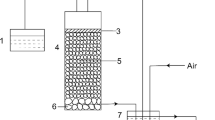Abstract
Microorganisms, one of the key factors affecting the bioleaching process, change the components of extracellular polymeric substance (EPS) and community structure to survive in leaching environments. In this work, Fourier transform infrared (FTIR), X-ray powder diffraction (XRD) and 16S rDna high-throughput sequence analyses were used to reveal the microbial changes in planktonic and sessile phases during bioleaching. The results showed the occupation of sessile cells decreased from 66.2% to (10±3)%. After bioleaching, the planktonic and sessile cells have similar EPS, but they are different from the original cells. Pyrite dissolution mainly occurs at the early and late stages with the decreasing of particle diameter, by 50% and 40%, respectively. The 16S rDna gene based sequence analysis results in total of 1117420 Reads across the six samples, presented among 7 phyla, 9 classes, 17 orders, 23 families and 31 genera. Genera Leptospirillum and Sulfobacillus are the main bacteria at the early and middle stages, and Leptospirillum is the main genus at the end of bioleaching. Aquabacterium and Acidovorax are special genera in sessile cells and Weissella is special in planktonic ones.
摘要
微生物是影响生物浸出过程的主要因素之一, 它通过改变胞外高分子物质(EPS)的组分和群落结构来适应浸出环境. 本文利用傅里叶变换红外光谱(FTIR)、 X 射线粉末衍射(XRD)和 16S rDNA 高通量序列分析, 揭示了生物浸出过程中游离和吸附微生物群落的变化. 结果表明, 吸附微生物由 66.2% 下降到(10±3)%. 生物浸出后的游离和吸附微生物具有相似的 EPS, 但与原始状态不同. 黄铁矿溶解主要发生在早期和晚期, 随着粒度的减小, 分别减少了 50%和 40%. 基于 16S rDNA 基因的序列分析结果显示, 6 个样品共有 1117420 个 Reads, 分布在 7 个门、 9 个纲、 17 个目、 23 个科、31 个属. Leptospirillum 和 Sulfobacillus 是早期和中期的主要菌种, Leptospirillum 是后期的主要菌属. Aquabacterium 和 Acidovorax 在吸附细胞中是特殊的属, 而 Weissella 是游离细胞中独有的.
Similar content being viewed by others
References
BOSECKER K. Bioleaching: Metal solubilization by microorganisms [J]. Fems Microbiology Reviews, 1997, 20(3, 4): 591–604. DOI: 10.1111/j.1574-6976.1997. tb00340.x.
MARTÍNEZ L C, VADYVALOO V. Mechanisms of post-transcriptional gene regulation in bacterial biofilms [J]. Frontiers in Cellular & Infection Microbiology, 2014, 4(4): 38. DOI: 10.3389/fcimb.2014.00038.
LUO W J, YANG H Y, JIN Z N. Study on the gold recovery of double refractory gold ore concentrate by biological oxidation pretreatment [J]. Advanced Materials Research, 2015, 1130: 379–382. DOI: 10.4028/www.scientific.net/AMR.1130.379.
CUI R C, YANG H Y, CHEN S, ZHANG S, LI K F. Valence variation of arsenic in bioleaching process of arsenic-bearing gold ore [J]. Transactions of Nonferrous Metals Society of China, 2010, 20(6): 1171–1176. DOI: 10.1016/S1003-6326 (09)60274-0.
NAYAK B. Mineral matter and the nature of pyrite in some high-sulfur tertiary coals of Meghalaya, northeast India [J]. Journal of the Geological Society of India, 2013, 81(2): 203–214. DOI: 10.1007/s12594-013-0023-9.
BEVILLQUA D, LAHTI H, P SUEGAMA H, GARAIA J O, ASSIS V B, JAAKKO A P, OLLI H T. Effect of Na-chloride on the bioleaching of a chalcopyrite concentrate in shake flasks and stirred tank bioreactors [J]. Hydrometallurgy, 2013, 138(113): 1–13. DOI: 10.1016/j.hydromet.2013.06.008.
YANG B, ZHAO C X, LUO W, LIAO R, GAN M, WANG J, LIU X, QIU G. Catalytic effect of silver on copper release from chalcopyrite mediated by Acidithiobacillus ferrooxidans [J]. J Hazard Mater, 2020, 392: 122290. DOI: 10.1016/j.jhazmat.2020.122290.
YANG B, LIN M, FANG J, ZHANG R, LUO W, WANG X, LIAO R, WU B, WANG J, GAN M, LIU B, ZHANG Y, LIU X, QIN W, QIU G. Combined effects of jarosite and visible lighton chalcopyrite dissolution mediated by Acidithiobacillus ferrooxidans [J]. Sci Total Environ, 2020, 698: 134175. DOI: 10.1016/j.scitotenv.2019.134175.
SCHIPPERS A, SAND W. Bacterial leaching of metal sulfides proceeds by two indirect mechanisms via thiosulfate or via polysulfides and sulfur [J]. Applied & Environmental Microbiology, 1999, 65(1): 319. DOI: 10.1128/AEM.65.1.319-321.1999.
HENRICI A T, JOHNSON D E. Studies of freshwater bacteria: II. stalked bacteria, a new order of schizomycetes [J]. Journal of Bacteriology, 1935, 30(1): 61. DOI: 10.1002/path.1700410212.
LI Q, SAND W. Mechanical and chemical studies on EPS from Sulfobacillus thermosulfidooxidans: From planktonic to biofilm cells [J]. Colloids & Surfaces B Biointerfaces, 2017, 153(Complete): 34–40. DOI: 10.1016/j.colsurfb.2017.02.009.
DENG Sha, GU Guo-hua, WU Zi-teng, XU Xiong-yi. Bioleaching of arsenopyrite by mixed cultures of iron-oxidizing and sulfur-oxidizing microorganisms [J]. Chemosphere, 2017, 185: 403–411. DOI: 10.1016/j.chemosphere.2017.07.037.
FLEMMING H C. The perfect slime [J]. Colloids & Surfaces B: Biointerfaces, 2011, 86(2): 251–259. DOI: 10.1016/j.colsurfb.2011.04.025.
KIWI J, NADTOCHENKO V. Evidence for the mechanism of photocatalytic degradation of the bacterial wall membrane at the TiO2 interface by ATR-FTIR and laser kinetic spectroscopy [J]. Langmuir, 2005, 21(10): 4631–4641. DOI: 10.1021/la046983l.
VILINSKA A, RAO K H. Surface characterization of acidithiobacillus ferrooxidans adapted to high copper and zinc ions concentration [J]. Geomicrobiology Journal, 2011, 28(3): 221–228. DOI: 10.1080/01490451.2010.489920.
XIA L, SHEN Z, VARGAS T, SUN W, RUAN R, XIE Z, QIU G. Attachment of Acidithiobacillus ferrooxidans onto different solid, substrates and fitting through Langmuir and Freundlich equations [J]. Biotechnology Letters, 2013, 35(12): 2129–2136. DOI: 10.1007/s10529-013-1316-1.
GEHRKE T, TELEGDI J, THIERRY D. Importance of extracellular polymeric substances from Thiobacillus ferrooxidans for bioleaching [J]. Applied & Environmental Microbiology, 1998, 64(7): 2743–2747. DOI: 10.0000/PMID9647862.
SHARMA P K, DAS A, RAO K H, FORSSBERG K S E. Surface characterization of Acidithiobacillus ferrooxidans cells grown under different conditions [J]. Hydrometallurgy, 2003, 71(1): 285–292. DOI: 10.0000/PMID9647862.
DIAO Meng-xue, NGUYEN T A H, TARAN E, MAHLER S, NGUYEN A V. Differences in adhesion of A. thiooxidans and A. ferrooxidans on chalcopyrite as revealed by atomic force microscopy with bacterial probes [J]. Minerals Engineering, 2014, 61(6): 9–15. DOI: 10.1016/j.mineng.2014.03.002.
DEVASIA P, NATARAJAN K A, SATHYANARAYANA D N, RAO G R. Surface chemistry of Thiobacillus ferrooxidans relevant to adhesion on mineral surfaces [J]. Applied and Environmental Microbiology, 1994, 59(12): 4051–4055. DOI: 10.1128/AEM.59.12.4051-4055.1993.
Author information
Authors and Affiliations
Corresponding author
Additional information
Foundation item: Project(U1608254) supported by the Special Fund for the National Natural Science Foundation of China; Projects(ZJKY2017(B)KFJJ01, ZJKY2017(B)KFJJ02) supported by the Zijin Mining Group Co., Ltd., China
Rights and permissions
About this article
Cite this article
Yin, L., Yang, Hy., Li, X. et al. Changes of microbial diversity during pyrite bioleaching. J. Cent. South Univ. 27, 1477–1483 (2020). https://doi.org/10.1007/s11771-020-4383-1
Received:
Accepted:
Published:
Issue Date:
DOI: https://doi.org/10.1007/s11771-020-4383-1
Key words
- pyrite dissolution
- sessile cells
- planktonic cells
- high-throughput sequence analysis
- microbial diversity
- bioleaching stage




